User:Furthershore/sandbox/Buddhism
| Part of a series on |
| Buddhism |
|---|
 |
Buddhism
Two major extant branches of Buddhism are generally recognized by scholars:
Mahayana Buddhism, which includes the traditions of
Buddhists number between an estimated 488 million[web 1] and 535 million,[15] making it one of the world's major religions.
Overview
Definition of Buddhism
This section needs expansion. You can help by adding to it. |
- Buddhism as a religion
- Buddhism as a philosophy
- Buddhism as a path of practice
- Buddhism as a science of mind
- Buddhism as a persuasion
Practice
Taking Refuge
Meditation
Schools and traditions
Buddhists generally classify themselves as either Theravada or Mahayana.[16] This classification is also used by some scholars[17] and is the one ordinarily used in the English language.[web 2] An alternative scheme used by some scholars[note 2] divides Buddhism into the following three traditions or geographical or cultural areas: Theravada, East Asian Buddhism and Tibetan Buddhism.
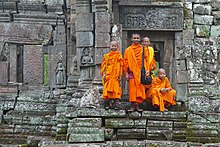
Some scholars
Not all traditions of Buddhism share the same philosophical outlook, or treat the same concepts as central. Each tradition, however, does have its own core concepts, and some comparisons can be drawn between them. For example, according to one Buddhist ecumenical organization,
- Both accept the Buddhaas their teacher.
- Both accept the Middle way, dependent origination, the Four Noble Truths, the Noble Eightfold Path and the Three marks of existence.
- Both accept that members of the laity and of the bodhi).
- Both consider buddhahood the highest attainment.
Philosophical roots
The roots of Classical Buddhism lie in the religious thought of
The shramanas circulated a core set of ideas: saṃsāra — the process of rebirth, the process by which one goes from one life to the next; karma (from Sanskrit: "action, work") — the force that drives saṃsāra; and moksha — Freedom, liberation from samsara.[24] The earliest records of the promulgation and development of these ideas is from the shramanas, however, the actual origin of these views is obscure.[25] Vedic Brahminism would later incorporate notions such as samsara, karma, and rebirth as well. [note 5]
This view is supported by a study of the region where these notions originated. Buddhism arose in Greater
At the same time, these movements were influenced by, and in some respects continued, philosophical thought within the Vedic tradition as reflected e.g. in the
Many of these new movements shared the same conceptual vocabulary—A particular criticism of the Buddha was Vedic animal sacrifice.
Life of the Buddha
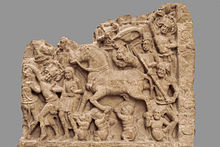
Authenticity of Narrative
This narrative draws on the Nidānakathā of the
According to author Michael Carrithers, while there are good reasons to doubt the traditional account, "the outline of the life must be true: birth, maturity, renunciation, search, awakening and liberation, teaching, death."[43] In writing her biography of the Buddha, Karen Armstrong noted, "It is obviously difficult, therefore, to write a biography of the Buddha that meets modern criteria, because we have very little information that can be considered historically sound... [but] we can be reasonably confident Siddhatta Gotama did indeed exist and that his disciples preserved the memory of his life and teachings as well as they could."[44][dubious ]
Early life
The evidence of the early texts suggests that Siddhārtha Gautama was born in a community that was on the periphery, both geographically and culturally, of the northeastern Indian subcontinent in the fifth century BCE.[45] It was either a small republic, in which case his father was an elected chieftain, or an oligarchy, in which case his father was an oligarch.[45]

Shortly after the birth of young prince Gautama, an astrologer named Asita visited the young prince's father, Suddhodana, and prophesied that Siddhartha would either become a great king or renounce the material world to become a holy man, depending on whether he saw what life was like outside the palace walls. Śuddhodana was determined to see his son become a king, so he prevented him from leaving the palace grounds. But at age 29, despite his father's efforts, Gautama ventured beyond the palace several times. In a series of encounters—known in Buddhist literature as the four sights—he learned of the suffering of ordinary people, encountering an old man, a sick man, a corpse and, finally, an ascetic holy man, apparently content and at peace with the world. These experiences prompted Gautama to abandon royal life and take up a spiritual quest.
Quest for Liberation
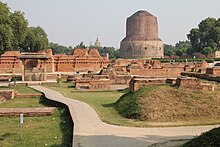
Gautama first went to study with famous religious teachers of the day, and mastered the meditative attainments they taught. But he found that they did not provide a permanent end to suffering, so he continued his quest. He next attempted an extreme asceticism, which was a religious pursuit common among the śramaṇas, a religious culture distinct from the Vedic one. Gautama underwent prolonged fasting, breath-holding, and exposure to pain. He almost starved himself to death in the process. He realized that he had taken this kind of practice to its limit, and had not put an end to suffering. So in a pivotal moment he accepted milk and rice from a village girl and changed his approach. He devoted himself to anapanasati meditation, through which he discovered what Buddhists call the Middle Way (Skt. madhyamā-pratipad):[46] a path of moderation between the extremes of self-indulgence and self-mortification.[web 5][web 6]

Gautama was now determined to complete his spiritual quest. At the age of 35, he famously sat in
History
The history of Indian Buddhism may be divided into five periods:
Vajrayana Buddhism).
Earliest teachings
Information of the oldest teachings may be obtained by analysis of the oldest texts. One method to obtain information on the oldest core of Buddhism is to compare the oldest extant versions of the Theravadin Pali Canon and other texts.[note 9] The reliability of these sources, and the possibility to draw out a core of oldest teachings, is a matter of dispute.[52][page needed][53][page needed][54][page needed][55][page needed] According to Vetter, inconsistencies remain, and other methods must be applied to resolve those inconsistencies.[50][note 10]
According to Schmithausen, three positions held by scholars of Buddhism can be distinguished:[59]
- "Stress on the fundamental homogeneity and substantial authenticity of at least a considerable part of the Nikayic materials;"[note 11]
- "Scepticism with regard to the possibility of retrieving the doctrine of earliest Buddhism;"[note 12]
- "Cautious optimism in this respect."[note 13]
Pre-sectarian Buddhism
Pre-sectarian Buddhism is the earliest phase of Buddhism, recognized by nearly all scholars. Its main scriptures are the
Early Buddhist schools
According to the scriptures, soon after the
According to most scholars, at some period after the Second Council the Sangha began to break into separate factions.
The root schism was between the
The Sthaviras gave rise to several schools, one of which was the Theravāda school. Originally, these schisms were caused by disputes over vinaya, and monks following different schools of thought seem to have lived happily together in the same monasteries, but eventually, by about 100 CE if not earlier, schisms were being caused by doctrinal disagreements too.[72]
Following (or leading up to) the schisms, each Saṅgha started to accumulate an
Early Mahayana Buddhism
Several scholars have suggested that the Prajñāpāramitā sūtras, which are among the earliest Mahāyāna sūtras,[74][75] developed among the Mahāsāṃghika along the Kṛṣṇa River in the Āndhra region of South India.[76]
The earliest Mahāyāna sūtras to include the very first versions of the
Anthony Barber and Sree Padma note that "historians of Buddhist thought have been aware for quite some time that such pivotally important Mahayana Buddhist thinkers as
There is no evidence that Mahāyāna ever referred to a separate formal school or sect of Buddhism, but rather that it existed as a certain set of ideals, and later doctrines, for bodhisattvas.
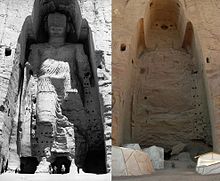
The Chinese monk Yijing who visited India in the 7th century CE, distinguishes Mahāyāna from Hīnayāna as follows:[88]
Both adopt one and the same Vinaya, and they have in common the prohibitions of the five offences, and also the practice of the Four Noble Truths. Those who venerate the bodhisattvas and read the Mahāyāna sūtras are called the Mahāyānists, while those who do not perform these are called the Hīnayānists.
Much of the early extant evidence for the origins of Mahāyāna comes from early Chinese translations of Mahāyāna texts. These Mahāyāna teachings were first propagated into China by
Late Mahayana Buddhism
During the period of Late Mahayana Buddhism, four major types of thought developed:
Vajrayana (Esoteric Buddhism)
Scholarly research concerning Esoteric Buddhism is still in its early stages and has a number of problems that make research difficult:[96]
- Vajrayana Buddhism was influenced by Hinduism, and therefore research must include exploring Hinduism as well.
- The scriptures of Vajrayana have not yet been put in any kind of order.
- Ritual must be examined as well, not just doctrine.
Development of Buddhism
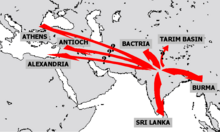
Buddhism may have spread only slowly in India until the time of the Mauryan emperor Ashoka, who was a public supporter of the religion. The support of Aśoka and his descendants led to the construction of more stūpas (Buddhist religious memorials) and to efforts to spread Buddhism throughout the enlarged Maurya empire and even into neighboring lands—particularly to the Iranian-speaking regions of Afghanistan and Central Asia, beyond the Mauryas' northwest border, and to the island of Sri Lanka south of India. These two missions, in opposite directions, would ultimately lead, in the first case to the spread of Buddhism into China, and in the second case, to the emergence of Theravāda Buddhism and its spread from Sri Lanka to the coastal lands of Southeast Asia.
This period marks the first known spread of Buddhism beyond India. According to the
The gradual spread of Buddhism into adjacent areas meant that it came into contact with new ethnical groups. During this period Buddhism was exposed to a variety of influences, from Persian and Greek civilization, to changing trends in non-Buddhist Indian religions—themselves influenced by Buddhism. Striking examples of this syncretistic development can be seen in the emergence of Greek-speaking Buddhist monarchs in the Indo-Greek Kingdom, and in the development of the Greco-Buddhist art of Gandhāra. A Greek king, Menander, has even been immortalized in the Buddhist canon.
The Theravada school spread south from India in the 3rd century BCE, to Sri Lanka and
The Silk Road transmission of Buddhism to China is most commonly thought to have started in the late 2nd or the 1st century CE, though the literary sources are all open to question.[98][note 19] The first documented translation efforts by foreign
In the 2nd century CE, Mahayana Sutras spread to China, and then to Korea and Japan, and were translated into Chinese. During the Indian period of Esoteric Buddhism (from the 8th century onwards), Buddhism spread from India to Tibet and Mongolia.
Buddhism today
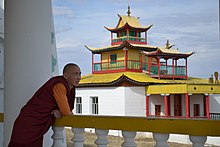
| Country | Estimated Buddhist population | Buddhists as % of total population |
|---|---|---|
| 13,701,660 | 96.90% | |
| 64,419,840 | 93.20% | |
| 38,415,960 | 80.10% | |
| 563,000 | 74.70% | |
| 14,455,980 | 69.30% | |
| 4,092,000 | 66.00% | |
| 1,520,760 | 55.10% | |
| 45,807,480 or 84,653,000 | 36.20% or 67%[102] | |
| 1,725,510 | 33.90% | |
| 4,945,600 or 8,000,000 | 21.10% or 35%[103] |
By the late Middle Ages, Buddhism had become virtually extinct in India, although it continued to exist in surrounding countries. It is now again gaining strength worldwide.[104][105] China and India are now starting to fund Buddhist shrines in various Asian countries as they compete for influence in the region.[web 7]
Most Buddhist groups in the West are nominally affiliated with at least one of these three traditions:
- Burma. The Dalit Buddhist movement in India (inspired by B. R. Ambedkar) also practices Theravada.
- East Asian forms of as well as such communities within Indochina, Southeast Asia and the West. Vietnam and Singapore are major concentrations of Mahayana Buddhism in Southeast Asia.
- India (it's the majority religion in Ladakh; significant population in Himachal Pradesh, Arunachal Pradesh and Sikkim), and Russia (mainly Kalmykia, Buryatia, and Tuva).
Formal membership varies between communities, but basic lay adherence is often defined in terms of a traditional formula in which the practitioner takes refuge in The
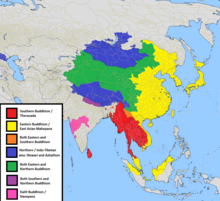
Overall there is an overwhelming diversity of recent forms of Buddhism.[note 20]
Demographics
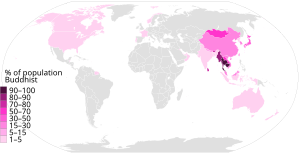
Buddhism is practiced by an estimated 488 million,[web 1] 495 million,[106] or 535 million[15] people as of the 2010s, representing 7% to 8% of the world's total population.
China is the country with the largest population of Buddhists, approximately 244 million or 18.2% of its total population.[web 1] They are mostly followers of Chinese schools of Mahayana, making this the largest body of Buddhist traditions. Mahayana, also practiced in broader East Asia, is followed by over half of world Buddhists.[web 1]
According to a demographic analysis reported by Peter Harvey (2013):[15] Mahayana has 360 million adherents; Theravada has 150 million adherents; and Vajrayana has 18,2 million adherents. Seven million additional Buddhists are found outside of Asia.
According to Johnson and Grim (2013), Buddhism has grown from a total of 138 million adherents in 1910, of which 137 million were in Asia, to 495 million in 2010, of which 487 million are in Asia.[106] According to them, there was a fast annual growth of Buddhism in Pakistan, Saudi Arabia, Lebanon and several Western European countries (1910–2010). More recently (2000–2010), the countries with highest growth rates are Qatar, the United Arab Emirates, Iran and some African countries.[107]
Late 20th century Buddhist movements
A number of modern movements or tendencies in Buddhism emerged during the second half of the 20th Century, including the
In the second half of the 20th Century a modern movement in Nichiren Buddhism: Soka Gakkai (Value Creation Society) emerged in Japan and spread further to other countries. Soka Gakkai International (SGI) is a lay Buddhist movement linking more than 12 million people around the world, and is currently described as "the most diverse"[110] and "the largest lay Buddhist movement in the world".[web 8]
See also
- Outline of Buddhism
- Buddhism by country
- Buddhism and science
- Chinese folk religion
- Easily confused Buddhist representations
- Iconography of Gautama Buddha in Laos and Thailand
- Index of Buddhism-related articles
- Indian religions
- List of books related to Buddhism
- List of Buddhist temples
- Nonviolence
Notes
- ^ "Buddhism". (2009). In Encyclopædia Britannica. Retrieved November 26, 2009, from Encyclopædia Britannica Online Library Edition
- ^ (Harvey 1990),(Gombrich,1984); Gethin (1998), pp. 1–2, identifies "three broad traditions" as: (1) "The Theravāda tradition of Sri Lanka and South-East Asia, also sometimes referred to as 'southern' Buddhism"; (2) "The East Asian tradition of China, Korea, Japan, and Vietnam, also sometimes referred to as 'eastern' Buddhism"; and, (3) "The Tibetan tradition, also sometimes referred to as 'northern' Buddhism."; Robinson & Johnson (1982) divide their book into two parts: Part One is entitled "The Buddhism of South Asia" (which pertains to Early Buddhism in India); and, Part Two is entitled "The Development of Buddhism Outside of India" with chapters on "The Buddhism of Southeast Asia", "Buddhism in the Tibetan Culture Area", "East Asian Buddhism" and "Buddhism Comes West; Penguin handbook of Living Religions, 1984, page 279; Prebish & Keown, Introducing Buddhism, ebook, Journal of Buddhist Ethics, 2005, printed ed, Harper, 2006
- ^ See e.g. the multi-dimensional classification in Encyclopedia of Religion[18]
- ^ According to Masih:[23] "Alongside Hinduism was the non-Aryan Shramanic culture with its roots going back to prehistoric times."
- ^ Padmanabh S. Jaini states:[26] "Yajnavalkya's reluctance and manner in expounding the doctrine of karma in the assembly of Janaka (a reluctance not shown on any other occasion) can perhaps be explained by the assumption that it was, like that of the transmigration of soul, of non-brahmanical origin. In view of the fact that this doctrine is emblazoned on almost every page of sramana scriptures, it is highly probable that it was derived from them."
Govind Chandra Pande:[27] "Early Upanishad thinkers like Yajnavalkya were acquainted with the sramanic thinking and tried to incorporate these ideals of Karma, Samsara and Moksa into the vedic thought implying a disparagement of the vedic ritualism and recognising the mendicancy as an ideal." - ^ Encyclopædia Britannica Online. Buddhism: The foundations of Buddhism, the cultural context. Retrieved 19-07-2009.
- " in P. 245 The Vinaya piṭakaṃ: one of the principle Buddhist holy scriptures ..., Volume 1 edited by Hermann Oldenberg
- ^ Hāṇḍā: "Even so have I, monks, seen an ancient way, an ancient road followed by the wholly awakened ones of olden time....Along that have I done, and the matters that I have come to know fully as I was going along it, I have told to the monks, nuns, men and women lay-followers, even monks, this Brahma-faring brahmacharya that is prosperous and flourishing, widespread and widely known become popular in short, well made manifest for gods and men."[38]
- Mahisasaka, Dharmaguptaka and other schools,[50][51] and the Chinese Agamas and other surviving portions of other early canons.[citation needed]
- ^ Exemplary studies are the study on descriptions of "liberating insight" by Lambert Schmithausen,[56] the overview of early Buddhism by Tilmann Vetter,[53] the philological work on the four truths by K.R. Norman,[57] the textual studies by Richard Gombrich,[55] and the research on early meditation methods by Johannes Bronkhorst.[58]
- ^ A proponent of the second position is Ronald Davidson.[subnote 3]
- ^ Well-known proponent of the third position are J.W. de Jong,[63][subnote 4] Johannes Bronkhorst[subnote 5] and Donald Lopez.[subnote 6]
- ^ Charles Prebish (2005). "Councils: Buddhist Councils". In Lindsay Jones (ed.). Encyclopedia of Religion. New York: Macmillan.
- ^ See Journal of the Pāli Text Society, volume XVI, p. 105
- ^ a b "Abhidhamma Pitaka." Encyclopædia Britannica. Ultimate Reference Suite. Chicago: Encyclopædia Britannica, 2008
- ^ "The most important evidence — in fact the only evidence — for situating the emergence of the Mahayana around the beginning of the common era was not Indian evidence at all, but came from China. Already by the last quarter of the 2nd century CE, there was a small, seemingly idiosyncratic collection of substantial Mahayana sutras translated into what Erik Zürcher calls 'broken Chinese' by an Indoscythian, whose Indian name has been reconstructed as Lokaksema."[89]
- ^ "The south (of India) was then vigorously creative in producing Mahayana Sutras" Warder[91]
- Hou Hanshu, and p. 31 for a translation of it.[99]
- ^ See Philosophy East and West, volume 54, page 270
Subnotes
- ^ According to A.K. Warder, in his 1970 publication "Indian Buddhism", from the oldest extant texts a common kernel can be drawn out.[51] According to Warder, c.q. his publisher: "This kernel of doctrine is presumably common Buddhism of the period before th great schisms of the fourth and third centuries BC. It may be substantially the Buddhism of the Buddha himself, although this cannot be proved: at any rate it is a Buddhism presupposed by the schools as existing about a hundred years after the parinirvana of the Buddha, and there is no evidence to suggest that it was formulated by anyone else than the Buddha and his immediate followers."[60]
- ^ Richard Gombrich: "I have the greatest difficulty in accepting that the main edifice is not the work of a single genius. By "the main edifice" I mean the collections of the main body of sermons, the four Nikāyas, and of the main body of monastic rules."[55]
- ^ Ronald Davidson: "While most scholars agree that there was a rough body of sacred literature (disputed)(sic) that a relatively early community (disputed)(sic) maintained and transmitted, we have little confidence that much, if any, of surviving Buddhist scripture is actually the word of the historic Buddha."[62]
- ^ J.W. De Jong: "It would be hypocritical to assert that nothing can be said about the doctrine of earliest Buddhism [...] the basic ideas of Buddhism found in the canonical writings could very well have been proclaimed by him [the Buddha], transmitted and developed by his disciples and, finally, codified in fixed formulas."[63]
- ^ Bronkhorst: "This position is to be preferred to (ii) for purely methodological reasons: only those who seek nay find, even if no success is guaranteed."[64]
- ^ Lopez: "The original teachings of the historical Buddha are extremely difficult, if not impossible, to recover or reconstruct."[65]
References
- ^ Wells 2008.
- ^ Roach 2011.
- ^ Lopez 2001, p. 239.
- ^ Lopez, Donald. "Buddha: Founder of Buddhism". Encyclopedia Britannica. Retrieved 6 March 2016.
- ^ Guang Xing (2005). The Three Bodies of the Buddha: The Origin and Development of the Trikaya Theory. Oxford: Routledge Curzon: pp.1 and 85
- ^ Gethin 1998, pp. 27–28, 73–74.
- )
- ISBN 978-1-55939-282-2.
- ^ "Candles in the Dark: A New Spirit for a Plural World" by Barbara Sundberg Baudot, p305
- ISBN 978-1-55939-282-2.
- ^ Williams 1998, pp. 275f.
- ^ Robinson 1998, p. xx.
- ^ Harvey 2013, p. 36-8.
- ^ Padmasambhava 2004, p. 111.
- ^ a b c Harvey 2013, p. 5.
- ^ Keown 1996, p. 12.
- ^ Smith 2006.
- ^ Eliade 1987, p. 440ff.
- ^ Gethin 2008, p. xv.
- ^ Buddhism: The foundations of Buddhism, The cultural context. In Encyclopædia Britannica. Retrieved 19-07-2009, from Encyclopædia Britannica Online Library Edition
- ^ Encyclopædia Britannica Online. Hinduism: History of Hinduism: The Vedic period (2nd millennium – 7th century BCE); Challenges to Brahmanism (6th – 2nd century BCE); Early Hinduism (2nd century BCE – 4th century CE). Retrieved 19-07-2009.
- ^ Warder 2000, p. 32.
- ^ Masih 2000, p. 18.
- ^ Masih 2000, p. 37.
- ^ Flood 1996, p. 86.
- ^ Jaini 2001, p. 51.
- ^ Pande 1994, p. 135.
- ^ Satapatha Brahmana 13.8.1.5
- ^ Oldenberg 1991.
- ^ Bronkhorst 2007.
- ^ Warder 2000, p. 30–32.
- ^ Warder 2000, p. 39.
- ^ Warder 2000, p. 33.
- ^ Gombrich 1988, p. 85.
- ^ Hardy 1863, p. 177.
- ^ Rhys Davids 1921, p. 494.
- ^ Hardy 1866, p. 44.
- ^ Hāṇḍā 1984, p. 57.
- ^ Rāhula 1974, p. 59.
- ^ Swearer 2004, p. 177.
- ^ Buswell 2004, p. 352.
- ^ Lopez 1995, p. 16.
- ^ Carrithers 1986, p. 10.
- ^ Armstrong 2004, p. xii.
- ^ a b Gombrich 1988, p. 49.
- ^ Kohn 1991, p. 143.
- ^ Keown 2003, p. 267.
- ^ Skilton 1997, p. 25.
- ^ Hirakawa 1993, p. 7.
- ^ a b Vetter 1988, p. ix.
- ^ a b Warder 1999.
- ^ Bronkhorst 1993.
- ^ a b Vetter 1988.
- ^ Schmithausen 1990.
- ^ a b c Gombrich 1997.
- ^ Schmithausen 1981.
- ^ Norman 1992.
- ^ Bronkhorst 1997.
- ^ Bronkhorst 1993, p. vii.
- ^ Warder et al.
- ^ Bronkhorst 1997, p. viii.
- ^ Davidson 2003, p. 147.
- ^ a b Jong 1993, p. 25.
- ^ Bronkhorst 1997, p. vii.
- ^ Lopez 1995, p. 4.
- ^ Mitchell 2002, p. 34.
- ^ Skorupski 1990, p. 5.
- ^ Bronkhorst 1998, pp. 4, 11.
- ^ Schopen 2002.
- ^ Williams 2005, pp. 175–176. sfn error: multiple targets (2×): CITEREFWilliams2005 (help)
- ^ Nattier 1977, pp. 237–272.
- ^ Harvey 1990, p. 74.
- ^ Keown 2004, p. 485.
- ^ Williams, Paul. Buddhist Thought. Routledge, 2000, pages 131.
- ^ Williams, Paul. Mahayana Buddhism: The Doctrinal Foundations 2nd edition. Routledge, 2009, pg. 47.
- ^ Guang Xing. The Concept of the Buddha: Its Evolution from Early Buddhism to the Trikaya Theory. 2004. pp. 65–66 "Several scholars have suggested that the Prajñāpāramitā probably developed among the Mahasamghikas in Southern India, in the Andhra country, on the Krsna River."
- ^ Akira, Hirakawa (translated and edited by Paul Groner) (1993). A History of Indian Buddhism. Delhi: Motilal Banarsidass: pp. 253, 263, 268
- ^ "The south (of India) was then vigorously creative in producing Mahayana Sutras" – Warder, A.K. (3rd edn. 1999). Indian Buddhism: p. 335.
- ^ Guang Xing. The Concept of the Buddha: Its Evolution from Early Buddhism to the Trikaya Theory. 2004. pp. 65–66
- ^ Warder, A.K. Indian Buddhism. 2000. p. 313
- ^ Padma, Sree. Barber, Anthony W. Buddhism in the Krishna River Valley of Andhra. SUNY Press 2008, pg. 1.
- ^ Padma, Sree. Barber, Anthony W. Buddhism in the Krishna River Valley of Andhra. SUNY Press 2008, pg. 2.
- ^ Akira, Hirakawa (translated and edited by Paul Groner) (1993. A History of Indian Buddhism. Delhi: Motilal Banarsidass: p. 252, 253
- ^ Nattier 2003, pp. 193–194.
- ^ Keown 1996, pp. 58, 61.
- ^ Williams 2008, pp. 4–5.
- ^ Williams 2000, p. 97.
- ^ Williams 2008, p. 5.
- ^ Buswell 2004, p. 492.
- ^ Hirakawa 1993, pp. 253, 263, 268.
- ^ Warder 2000, p. 335.
- ^ Hirakawa 1993, pp. 8, 9.
- ^ Harvey 1990, p. 95.
- ^ Lusthaus 2002, p. 236–237.
- ^ Harvey 1990, p. 113.
- ^ Hirakawa 1993, p. 9.
- ^ Gombrich, Theravada Buddhism, Routledge, 2nd ed, 2006, page 135
- ^ Zürcher 1972, pp. 22–27.
- ^ Hill 2009, pp. 30–31.
- ^ Zürcher 1972, pp. 23.
- ^ Pew Research Center 2012.
- ^ [1]
- ^ [2]
- ^ Henderson 2002, p. 42.
- ^ Tamney 1998, p. 68.
- ^ a b Johnson 2013, pp. 34–37.
- ^ Johnson 2013, p. 36.
- ^ Paranjpe 1998, p. 351.
- ^ Pavāra 2009, pp. xv–xviii.
- ^ Métraux 2010, p. vi.
Sources
- Ajahn Sucitto (2010), Turning the Wheel of Truth: Commentary on the Buddha's First Teaching, Shambhala
- ISBN 0-14-303436-7
- Bareau, André (1955), 'Les Sectes bouddhiques du Petit Véhicule, Saigon: École Française d'Extrême-Orient
- Bechert, Heinz; ISBN 0500250898)
{{citation}}:|author=has generic name (help)CS1 maint: multiple names: authors list (link - ISBN 0861713311
- Bronkhorst, Johannes(1993), The Two Traditions Of Meditation In Ancient India, Motilal Banarsidass Publ.
- Bronkhorst, Johannes (1998), "Did the Buddha Believe in Karma and Rebirth?", Journal of the International Association of Buddhist Studies 21 (1), 1–20
- Bronkhorst, Johannes (2007), Greater Magadha, Studies the Culture of Early India. Series: Handbook of Oriental Studies, Section 2 South Asia Series, Brill Academic Publishers Inc, ISBN 978-90-04-11519-4
- ISBN 978-0-02-865718-9
- ISBN 978-0-02-865718-9
- Carrithers, Michael (1983), The Buddha, Oxford [England]; New York: Oxford University Press
- Carrithers, Michael (1986), Founders of faith, Oxford [England]; New York: Oxford University Press, ISBN 019283066X
- ISBN 1-57062-921-8
- ISBN 9780415397254
- ISBN 0674001877
- ISBN 9780877040491
- ISBN 9781844831258
- , retrieved 2007-07-11; reprinted in Williams, Buddhism, volume I; NB in the online transcript a little text has been accidentally omitted: in section 4, between "... none of the other contributions in this section envisage a date before 420 B.C." and "to 350 B.C." insert "Akira Hirakawa defends the short chronology and Heinz Bechert himself sets a range from 400 B.C."
- Crawford, S. Cromwell (1972), "Review: Brahmanism, Buddhism and Hinduism by Lal Mani Joshi", Philosophy East and West, 22 (1): 114–116, JSTOR 1397971
- Davidson, Ronald M. (2003), Indian Esoteric Buddhism: A Social History of the Tantric Movement, New York: Columbia University Press, ISBN 0-231-12619-0
- de Give, Bernard (2006), Les rapports de l'Inde et de l'Occident des origines au règne d'Asoka, Les Indes savants, ISBN 2-84654-036-5
- Donath, Dorothy C. (1971), Buddhism for the West: Theravāda, Mahāyāna and Vajrayāna; a comprehensive review of Buddhist history, philosophy, and teachings from the time of the Buddha to the present day, Julian Press, ISBN 0-07-017533-0
- Dumoulin, Heinrich; Heisig, James W.; Knitter, Paul F. (1988), Zen Buddhism: A History (India and China), London: Collier Macmillan
{{citation}}: CS1 maint: multiple names: authors list (link) - Dzongsar Jamyang Khyentse(2011), What Makes You Not a Buddhist, Shambhala, Kindle Edition
- Eliade, Mircea; Adams, Charles J. (1987), The Encyclopedia of religion, New York: Macmillan
{{citation}}: CS1 maint: multiple names: authors list (link) - Eliot, Charles (1935), Japanese Buddhism, London: Edward Arnold & Co.
- ISBN 0-231-06651-1)
{{citation}}:|author=has generic name (help)CS1 maint: multiple names: authors list (link - ISBN 0-521-43878-0
- ISBN 0-19-289223-1.
- Gethin, Rupert (2008). Sayings of the Buddha. Oxford University Press.
- Goldstein, Joseph (2002). "One Dharma: The Emerging Western Buddhism". HarperCollins.
{{cite journal}}: Cite journal requires|journal=(help) - Goleman, Daniel (2008). Destructive Emotions: A Scientific Dialogue with the Dalai Lama. Bantam. Kindle Edition.
- ISBN 0-415-07585-8
- Gombrich, Richard F. (1997), How Buddhism Began, Munshiram Manoharlal
- Gombrich, Richard F. (2006), in Williams, Paul, ed., Buddhism: Critical Concepts in Religious Studies, 8 volumes, London: Routledge
- ISBN 978-0-9789067-7-1
- Hāṇḍā, Omacanda (1984), Buddhist art & antiquities of Himachal Pradesh, upto 8th century A.D., New Delhi: Indus Pub. Co., ISBN 818518299X
- Hardy, Robert Spence (1863), The sacred books of the Buddhists compared with history and modern science, Colombo, printed at the Wesleyan mission Press
- Hardy, Robert Spence (1866), The legends and theories of the Buddhists, compared with history and science, London, Edinburgh: Williams and Norgate
- Harvey, Peter (1990), An Introduction to Buddhism: Teachings, History and Practices, Cambridge University Press, ISBN 0-521-31333-3
- Harvey, Peter (2013). An Introduction to Buddhism: Teachings, History and Practices (2nd ed.). Cambridge, UK: Cambridge University Press. ISBN 9780521676748.
- Harvey, Peter (1995), The Selfless Mind, Curzon Press
- Hawkins, Bradley K. (1999), The Pocket Idiots Guide: Buddhism, Laurence King (Penguin, Alpha), ISBN 0-02-864459-X
- Henderson, Carol E. (2002), Culture and Customs of India, Greenwood Publishing Group
- Hill, John E. (2009), Through the Jade Gate to Rome: A Study of the Silk Routes during the Later Han Dynasty, 1st to 2nd Centuries CE, Charleston, South Carolina: BookSurge, ISBN 978-1-4392-2134-1
- Hirakawa, Akira; Groner, Paul (trans.; ed.) (1993). A History of Indian Buddhism. Delhi: Motilal Banarsidass. ISBN 8120809556.)
{{cite book}}: CS1 maint: multiple names: authors list (link - ISBN 0824823834
- Hodge, Stephen (2002), Zen Masterclass, Godsfield Press
- ISBN 81-208-1776-1
- Johnson, Todd M.; Grim, Brian J. (2013). The World's Religions in Figures: An Introduction to International Religious Demography (PDF). Hoboken, NJ: Wiley-Blackwell. pp. 34–37. Archived from the original (PDF) on 2013-10-20.
- Jong, J.W. de (1993), "The Beginnings of Buddhism", The Eastern Buddhist, Vol. 26, No. 2
- Kalupahana, David (1966), "Sarvastivada and its theory of sarvam asti", University of Ceylon Review 24, 94–105
- Kanno, Hiroshi (2004). "Huisi's Perspective on the Lotus Sutra as Seen Through the Meaning of the Course of Ease and Bliss in the Lotus Sutra" (PDF). Journal of the Institute of Oriental Philosophy 14, 146–166. Archived from the original (PDF) on 2011-07-19. Retrieved February 5, 2010.
- Kasulis, T. P. (2006), "Zen as a Social Ethics of Responsiveness" (PDF), Journal of Buddhist Ethics 13, 1–12, archived from the original (PDF) on 2009-03-25
- Keown, Damien (2000) [1996], Buddhism: A Very Short Introduction, Oxford University Press, Kindle Edition
- Keown, Damien (2003), Dictionary of Buddhism, ISBN 0-19-860560-9
- Keown, Damien; Prebish, Charles S. (2004), Encyclopedia of Buddhism, London: Routledge, ISBN 978-0-415-31414-5)
{{citation}}: CS1 maint: multiple names: authors list (link - Keown, Damien; Prebish, Charles S. (2007), Encyclopedia of Buddhism, London: Routledge
{{citation}}: CS1 maint: multiple names: authors list (link) - Kohn, Michael H. (trans.) (1991), The Shambhala Dictionary of Buddhism and Zen, Shambhala, ISBN 0-87773-520-4
- Lama Surya Das (1997), Awakening the Buddha Within, Broadway Books, Kindle Edition
- ISBN 0-7100-8540-0
- Lindtner, Christian (1997), Master of Wisdom, Dharma Publishing
- ISBN 0-691-04442-2
- Lopez, Donald S. (2001), The Story of Buddhism, HarperCollins
- Lowenstein, Tom (1996), The Vision of the Buddha, Duncan Baird Publishers, ISBN 1-903296-91-9
- Lusthaus, Dan (2002), Buddhist Phenomenology, Routledge
- Mäll, Linnart (2005), Studies in the Astasahasrika Prajnaparamita and Other Essays, Delhi: Motilal Banarsidass
- Masih, Yakub (2000), A Comparative Study of Religions, Delhi: Motilal Banarsidass, ISBN 81-208-0815-0
- Matthews, Bruce (1986), Post-Classical Developments In The Concepts of Karma and Rebirth in Theravada Buddhism. In: Ronald W. Neufeldt (ed.), "Karma and rebirth: Post-classical developments", SUNY
- McFarlane, Stewart (2001), in Peter Harvey, ed., Buddhism, Continuum
- Métraux, Daniel A. (2010). How Soka Gakkai Became a Global Buddhist Movement. ISBN 9780773437586.
- Miller, Barbara Stoler (1996), Yoga: Discipline of Freedom: the Yoga Sutra Attributed to Patanjali; a Translation of the Text, with Commentary, Introduction, and Glossary of Keywords, University of California Press
- Mitchell, Donald W. (2002), Buddhism: introducing the Buddhist experience, Oxford University Press, ISBN 0195139518
- Mizuno, Kogen (1996), Essentials of Buddhism : basic terminology and concepts of Buddhist philosophy and practice, Tokyo: Kosei, ISBN 4333016835
- Morgan, Peggy; ISBN 978-0-7486-2330-3
- Morgan, Kenneth W., ed. (1956), The Path of the Buddha: Buddhism Interpreted by Buddhists, New York: Ronald Press
- Ñāṇamoli, Bhikkhu; Bodhi, Bhikkhu (1995). The middle length discourses of the Buddha : a new translation of the Majjhima Nikaya. Wisdom Pub.
- Nattier, Jan (2003), A Few Good Men: The Bodhisattva Path according to The Inquiry of Ugra (Ugrapariprccha), University of Hawai'i Press, ISBN 0-8248-2607-8
- Nattier, Jan; Prebish, Charles S. (1977), "Mahāsāṅghika Origins: the beginnings of Buddhist sectarianism in History of Religions", History of Religions 16, 237–272, )
- Norman, K.R. (1997), A Philological Approach to Buddhism. The Bukkyo Dendo Kybkai Lectures 1994 (PDF), School ofOriental and African Studies (University of London)
- Oldenberg, Hermann (1991), The Doctrine of the Upanishads and Early Buddhism, Delhi: Motilal Banarsidass(reprint)
- Onians, Isabelle (2001), "Tantric Buddhist Apologetics, or Antinomianism as a Norm," PhD dissertation, Oxford, Trinity Term
- Padmasambhava, Jamgon Kongtrul; ISBN 978-962-7341-37-6, retrieved 2010-08-25
- ISBN 81-208-1104-6
- Paranjpe, A. C. (30 September 1998), Self and identity in modern psychology and Indian thought, Springer, ISBN 978-0-306-45844-6, retrieved 10 March 2012
- ISBN 978-0-231-14900-6, retrieved 10 March 2012
- Payne, Richard K. (2006), Tantric Buddhism in East Asia, Boston: Wisdom Publications, ISBN 0861714873
- Pew Research Center (2012), The Global Religious Landscape: A Report on the Size and Distribution of the World's Major Religious Groups as of 2010 (PDF), Pew Research Center, retrieved 9 October 2013
- Pinburn, Sidney (2001), The Dalai Lama: Policy of Kindness, Snow Lion
- Prebish, Charles (1993), Historical Dictionary of Buddhism, The Scarecrow Press, ISBN 0-8108-2698-4
- Prebish, Charles S; Keown, Damien (2006). Introducing Buddhism. Routledge.
- Pyysiäinen, Ilkka (2003), "Buddhism, Religion, and the Concept of "God"", Man, 50 (2): 147–171, JSTOR 3270517
- ISBN 955-9219-19-7
- Ranjini (22 January 1991), "Jewels of the Doctrine", Buddhist Stories of the Thirteenth Century, Sri Satguru Publications, ISBN 0-7914-0490-0
- Rhys Davids, T.W.; Stede, William (1921), The Pali Text Society's Pali-English dictionary, Chipstead, London: Pali Text Society
- Roach, Peter (2011), Cambridge English Pronouncing Dictionary (18th ed.), Cambridge: Cambridge University Press, ISBN 9780521152532
- Robinson, Richard H. (1982), The Buddhist Religion: A Historical Introduction (3rd ed.), Belmont, California: Wadsworth Publishing, ISBN 0-534-01027-X
- Robinson, Richard H.; Johnson, Willard L . (1977), The Buddhist Religion, Belmont, Calif.: Dickenson Publ.
- Samuel, Geoffrey (2008), The Origins of Yoga and Tantra, Cambridge University Press, ISBN 978-0-521-69534-3
- Schmithausen, Lambert (1981), On some Aspects of Descriptions or Theories of 'Liberating Insight' and 'Enlightenment' in Early Buddhism". In: Studien zum Jainismus und Buddhismus (Gedenkschrift für Ludwig Alsdorf), hrsg. von Klaus Bruhn und Albrecht Wezler, Wiesbaden 1981, 199–250
- Schmithausen, Lambert (1986), Critical Response. In: Ronald W. Neufeldt (ed.), "Karma and rebirth: Post-classical developments", SUNY
- Schopen, Gregory (2002), Bones, Stones, and Buddhist Monks, University of Hawai'i Press
- Sebastian, C.D. (2005), Metaphysics and Mysticism in Mahayana Buddhism, Delhi: Sri Satguru Publications
- Shaw, Sarah (2006), Buddhist Meditation: An Anthology of Texts from the Pāli Canon, Routledge
- Silk, Jonathan A. (2002), "What, if anything, is Mahayana Buddhism?", Numen 49:4, 335–405
- Sinha, H.P. (1993), Bhāratīya Darshan kī rūprekhā (Features of Indian Philosophy), Motilal Banarasidas Publ., ISBN 81-208-2144-0
- Skilling, Peter (1992), "The Raksā Literature of the Śrāvakayāna" (PDF), Journal of the Pali Text Society 16, 109–182
- Skilton, Andrew (1997), A Concise History of Buddhism, Windhorse Publications, ISBN 0-904766-92-6
- Skorupski, Tadeusz, ed. (1990), Buddhist Forum, vol I, Routledge, ISBN 0728601621)
{{citation}}:|first=has generic name (help)CS1 maint: multiple names: authors list (link - ISBN 978-0-06-073067-3
- Smith (2006), "Buddhism". In Juergensmeyer, Mark, The Oxford Handbook of Global Religions, Oxford Handbooks in Religion and Theology, Oxford University Press, ISBN 978-0-19-513798-9
- Southwold, Martin (1978). "Buddhism and The Definition of Religion". Man. 13 (3): 362–379. JSTOR 2801935.
- Swearer, Donald (2004), Becoming the Buddha: the ritual of image consecration in Thailand, Princeton, N.J.: Princeton University Press, ISBN 0691114358
- Tamney, Joseph B. (1998), in William H. Swatos, editor, Encyclopedia of Religion and Society, Rowman Altamira
- Thanissaro Bhikkhu (2001), Refuge: An Introduction to the Buddha, Dhamma, & Sangha (3rd ed., rev.)
- ISBN 0-7679-0369-2
- )
- Uchiyama, Kōshō (1993), Opening the Hand of Thought: Approach to Zen, New York: Penguin Books
- Upadhyaya, Kashi Nath (1998), Early Buddhism and the Bhagavadgita, Motilal Banarsidass Publ.
- Vetter, Tilmann (1988), The Ideas and Meditative Practices of Early Buddhism, BRILL
- Wallace, B. Alan (2007), Contemplative Science, Columbia University Press
- Warder, A.K. (2000), Indian Buddhism, Delhi: Motilal Banarsidass Publishers
- Welch, B. Alan (1967), The practice of Chinese Buddhism, 1900–1950, Cambridge: Harvard University Press
- ISBN 9781405881180
- Werner, Karel, ed. (1989), The Longhaired Sage in The Yogi and the Mystic, Curzon Press
- White, Kenneth (2005), The Role of Bodhicitta in Buddhist Enlightenment Including a Translation into English of Bodhicitta-sastra, Benkemmitsu-nikyoron, and Sammaya-kaijo, The Edwin Mellen Press ISBN 0-7734-5985-5.
- Williams, Paul (1989), Mahayana Buddhism: the doctrinal foundations, London: Routledge, ISBN 0-415-02537-0
- Williams, Paul, ed. (2005), Buddhism: Critical Concepts in Religious Studies, 8 volumes, London: Routledge
- Williams, Paul (2005), Buddhism: The early Buddhist schools and doctrinal history ; Theravāda doctrine, Taylor & Francis, ISBN 978-0-415-33228-6
- Williams, Paul (2008), Mahayana Buddhism: the doctrinal foundations, London: Routledge, ISBN 9780415356534
- Williams, Paul; Tribe, Anthony (2000), Buddhist Thought, London: Routledge, ISBN 0-415-20701-0
- Wynne, Alexander (2007), The Origin of Buddhist Meditation, London: Routledge, ISBN 9780415423878
- Yamamoto, Kosho, trans.; Page, Tony , ed. (1999), )
- )
- Zürcher, Erik (1972), The Buddhist Conquest of China, Leiden E. J. Brill
Online sources
- ^ a b c d Pew Research Center. "Global Religious Landscape: Buddhists". Pew Research Center.
- ^ "Tibetan Buddhism". American Heritage Dictionary of the English Language. Houghton Mifflin Company. 2004. Archived from the original on 2008-06-09. Retrieved 2007-07-07.
- ^ Tan Swee Eng. "A Comparative Study of the Schools". Shippensburg University.
- ^ Cite error: The named reference
auto2was invoked but never defined (see the help page). - ^ "The Middle Way of the Buddha". Buddhamind.info. Retrieved 2011-10-24.
- ^ "Buddhism – The Middle Path". Buddhanet.net. Retrieved 2011-10-24.
- ^ Subir Bhaumik. "China and India use Buddha for regional karma". Aljazeera.com. Archived from the original on 2015-03-20. Retrieved 2013-06-18.
- ^ Gier, Nick. "The Virtues of Asian Humanism. Keynote Address at the 40th Annual MeetingInstitute of Oriental Philosophy, Soka University, Japan". University of Idaho. Archived from the original on 2013-06-10. Retrieved 1 April 2015.
External links
- Frequently Asked Questions About Buddhism
- Religion and Spirituality: Buddhism at Open Directory Project
- "Buddhism — objects, art and history". Asia. Victoria and Albert Museum. Retrieved 2007-12-06.
- Buddhist texts at Sacred Texts.com
- Buddhism in various languages
- The Future of Buddhism series, from Patheos
- Thanissaro Bhikkhu. "Emptiness". A Theravada Library. Retrieved 2012-12-19.
- Berzin, Alexander (November 2001). "History of Buddhism in Afghanistan". Berzin Archives.
- Wei, Wei Wu (1960). "Why Lazarus Laughed: The Essential Doctrine Zen-Advaita-Tantra". Routledge and Kegan Paul Ltd., London. Sentient Publications. Retrieved 2010-11-10.
{{cite web}}: External link in|author= - Dhammananda, K. Sri (2002). "What Buddhists Believe" (PDF). Archived from the original (PDF) on 2013-08-08. Retrieved 2010-11-10.
- Buddhism in China, and how it alternates with Confucianism
Category:Transtheism Category:Gautama Buddha Category:Indian religions
